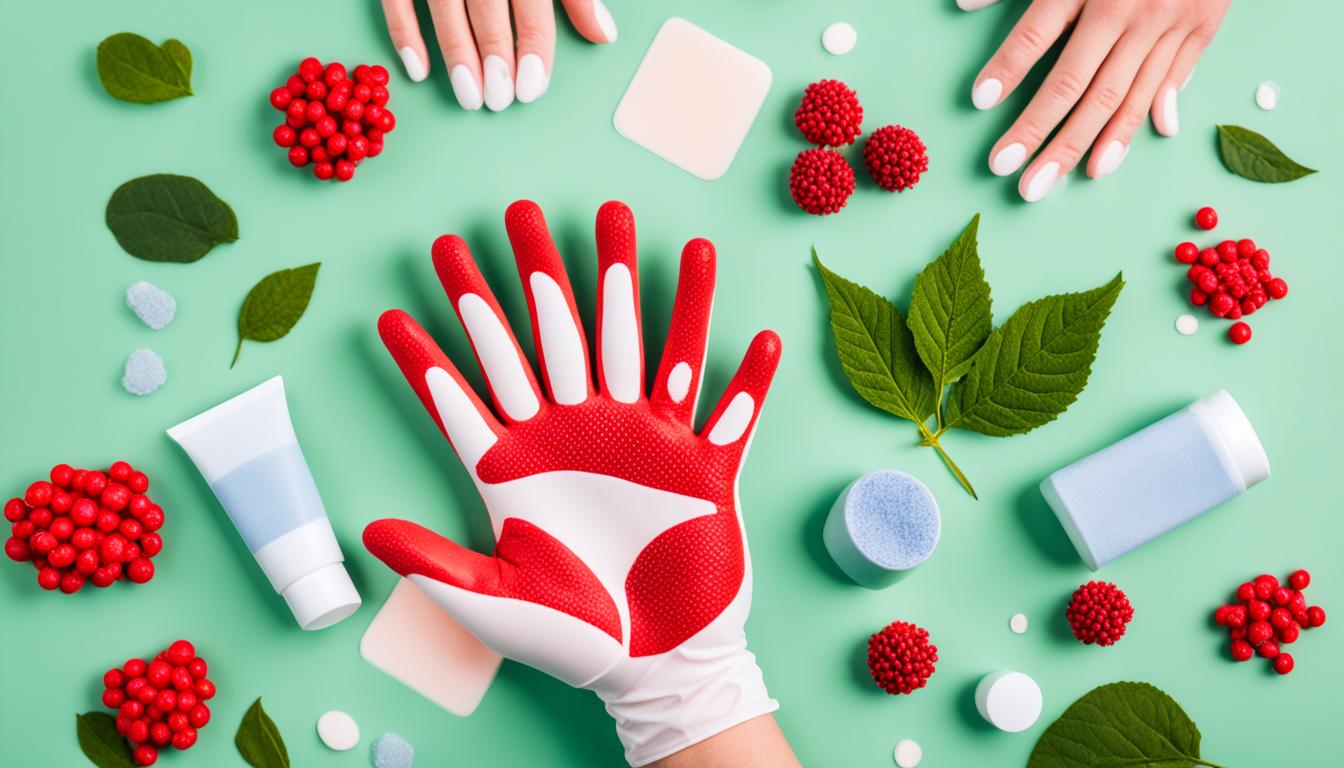Dermatitis contact is a skin problem. It happens when you touch something you’re allergic to or something that irritates the skin. You may see redness, itchiness, swelling, and blisters. The rash could come from harsh chemicals (irritant) or from an allergy to something like nickel in jewelry (allergic).
The doctor finds the cause by talking about your health, looking at your skin, and sometimes doing a test. This test helps them know what you’re allergic to or what irritates your skin. Sometimes, plants like poison ivy can also cause this.
To treat it, you usually need to stay away from what’s causing it. You might use medicine on your skin to make it better and take pills to stop the itch. In tough cases, stem cell therapy might help. This new treatment is showing some hope in making skin problems go away.
Key Takeaways:
- Dermatitis contact is a skin condition triggered by allergens or irritants.
- Symptoms often show as redness, itchiness, swelling, and blisters.
- Main types are caused by harsh substances or by allergic reactions.
- Common culprits include metals, makeup, scents, and plants like poison ivy.
- Finding the cause involves asking about your health and checking your skin, and sometimes special tests.
- Treatments focus on removing the triggers, using skin medicines, and stopping the itch with pills.
- For hard-to-treat cases, stem cell therapy offers a new and promising option.
Causes of Contact Dermatitis
Many things we touch can cause contact dermatitis. These things are called allergens or irritants. Knowing these culprits helps us avoid them.
Here are some common things that cause it:
- Allergens: Metals such as nickel can spark allergies. So can some cosmetics and perfumes.
- Irritants: Strong chemicals in soaps and cleaning products can make the skin red and itchy.
- Plants: Some plants like poison ivy can create a rash. They have oil that many people are allergic to.
- Other Causes: Things like latex, certain drugs, and even the sun can also lead to contact dermatitis.
It’s crucial to know what could harm our skin. This knowledge helps protect us from contact dermatitis.
Common Causes of Contact Dermatitis
| Allergens | Irritants | Plants | Other Causes |
|---|---|---|---|
| Nickel, cobalt, chromium | Soaps, detergents, solvents, chemicals | Poison ivy, poison oak, poison sumac | Latex, certain medications, sunlight |
| Certain cosmetics and personal care products | |||
| Fragrances |
Diagnosis and Treatment of Contact Dermatitis
To diagnose contact dermatitis, doctors look into your medical past and check your skin. They might also do patch tests. Patch tests find out what’s causing the reaction. This way, doctors know how to treat it effectively.
During a patch test, doctors put small amounts of substances on your skin with patches. This test shows which ones cause your dermatitis. It’s very helpful when the allergen or irritant is not clear.
Treating contact dermatitis often means avoiding what causes it. You might need to change your daily products or stay away from certain things like plants.
Topical corticosteroids are common medicines for it. You apply these creams directly on your skin. They help with redness, itching, and swelling.
Antihistamines can also be used. They stop the allergic reaction, which helps with itching.
If your condition is serious and normal treatments don’t work, you might try stem cell therapy. This newer approach can improve healing and immune system responses.
Treatment Options for Contact Dermatitis
There are different ways to treat contact dermatitis. It depends on how bad it is and what causes it. Here are some options:
- Topical corticosteroids: These reduce inflammation and ease your symptoms.
- Antihistamines: They help cut down itching and the allergic response.
- Avoiding triggers: The best way is to stay away from what causes your dermatitis.
- Stem cell therapy (in severe cases): This new option improves healing by changing the immune response.
| Treatment | Description |
|---|---|
| Topical corticosteroids | You put these medications right on where it’s needed. They soothe inflammation and symptoms. |
| Antihistamines | You can take them by mouth or put them on your skin. They ease itching and allergic responses. |
| Avoiding triggers | This is key to stopping contact dermatitis. Find and stay away from the things that set it off. |
| Stem cell therapy | A new way to treat it. Stem cells help healing and change the immune response. |
Conclusion
Contact dermatitis is a common skin issue. Many things can cause it, such as allergens and irritants. It’s key to find and stay away from these things to avoid this condition. Doctors can figure out what’s causing your skin problems through tests like patch testing.
Doctors often treat this condition with medicines like topical corticosteroids. These help reduce swelling and itching. Antihistamines can also be used for itch relief. For severe cases, treatments such as stem cell therapy may be an option. They work by helping your body heal better.
Preventing contact dermatitis is crucial. This can be done by staying away from things you know could hurt your skin. Using hypoallergenic products can also help. By knowing how to prevent, diagnose, and treat this issue, people can improve their lives. They can enjoy healthier skin and less discomfort.

